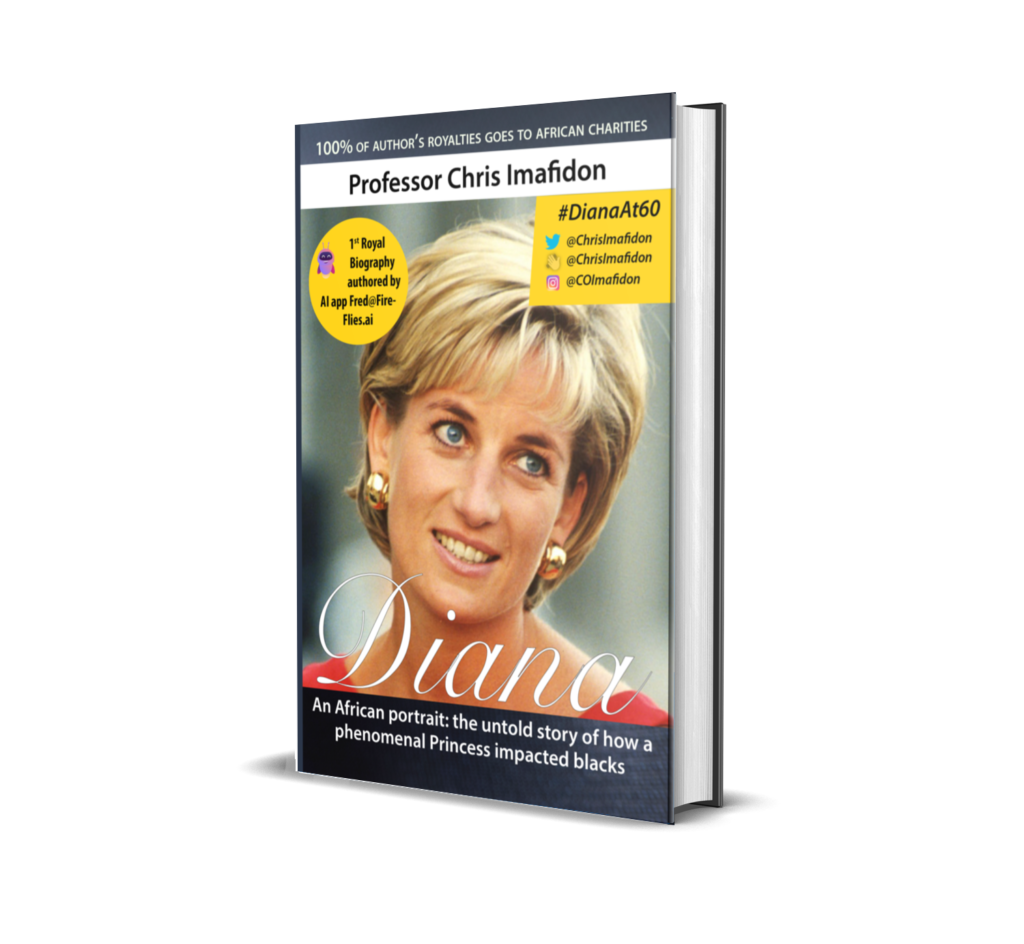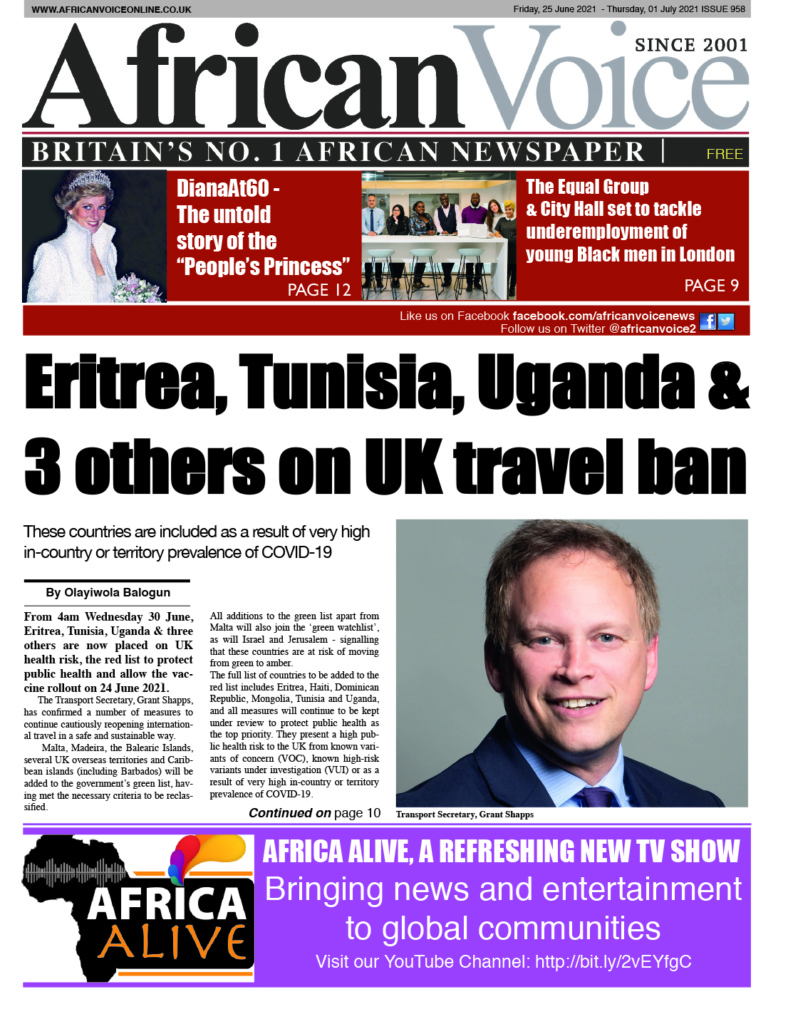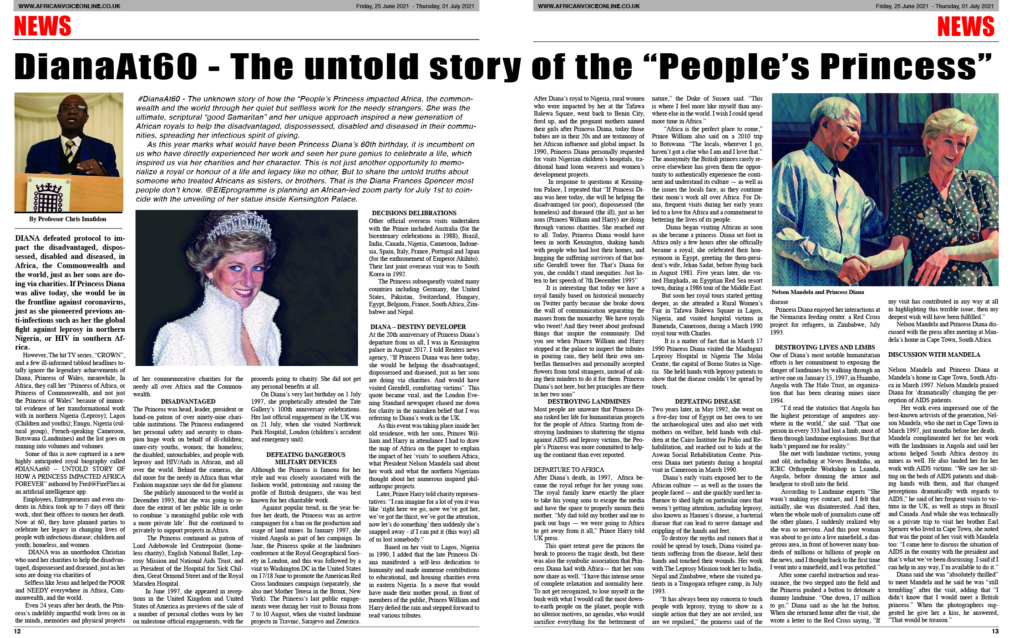
#DianaAt60 – The unknown story of how the “People’s Princess impacted Africa, the commonwealth and the world through her quiet but selfless work for the needy strangers. She was the ultimate, scriptural “good Samaritan” and her unique approach inspired a new generation of African royals to help the disadvantaged, dispossessed, disabled and diseased in their communities, spreading her infectious spirit of giving.”
As this year marks what would have been Princess Diana’s 60th birthday, it is incumbent on us who have directly experienced her work and seen her pure genius to celebrate a life, which inspired us via her charities and her character. This is not just another opportunity to memorialize a royal or honour a life and legacy like no other, But to share the untold truths about someone who treated Africans as sisters, or brothers. That is the Diana Frances Spencer most people don’t know. @EIEprogramme is partnering with African institutions for a record 7-day 60th birthday celebration of Princess Diana from June 27th to 3rd July, to coincide with the unveiling of her statue inside Kensington Palace on 1stJuly. Limited FREE tickets available here: https://bit.ly/3jkJhaV



By Professor Chris Imafidon – DIANA defeated protocol to impact the disadvantaged, dispossessed, disabled and diseased, in Africa, the Commonwealth and the world, just as her sons are doing via charities. If Princess Diana was alive today, she would be in the frontline against coronavirus, just as she pioneered previous anti-infections such as her the global fight against leprosy in northern Nigeria, or HIV in southern Africa. However, The hit TV series, “THE CROWN”, and a few ill-informed tabloid headlines totally ignore the legendary achievements of Diana, Princess of Wales. In Africa, they call her “Princess of Africa, or Princess of Commonwealth, and not just the Princess of Wales” because of immortal evidence of her transformational work with in northern Nigeria (Leprosy); Lagos (Children and youths); Enugu, Nigeria (cultural group), French-speaking Cameroon, Botswana (Landmines) and the list goes on running into volumes and volumes.
Some of this is now captured in a new highly anticipated royal biography called #DIANAat60 – UNTOLD STORY OF HOW A PRINCESS IMPACTED AFRICA” authored by Fred@FireFlies.ai, an artificial intelligence app.
Employees, entrepreneurs and even students in Africa took up to 7 days off their work, shut their offices to mourn her death. Now at 60, they have planned parties to celebrate her legacy in changing lives of people with infectious disease; children and youth; homeless, and women.
DIANA was an unorthodox Christian who used her charities to help the disadvantaged, dispossessed and diseased, just as her sons are doing via charities. Some Africans believe that Diana’s principles where based on the biblical verse of Luke 4:18.
Diana was selfless like Jesus and helped the POOR and NEEDY everywhere in Africa. Even 24 years after her death, the Princess’s indelibly impactful work lives on in the minds, memories and physical projects of her commemorative charities for the needy all over Africa and the Commonwealth.
DISADVANTAGED
The Princess was a hand-on patron of over ninety-nine charitable institutions. The Princess endangered her personal safety and security to champion huge work on behalf of ill-children; inner-city youths, women; the homeless; the disabled; untouchables; and people with leprosy and HIV/Aids in Africa, and all over the world. Behind the cameras, she did more for the needy in Africa than what Fashion magazine says she did for glamour.
She publicly announced to the world in December 1993, that she was going to reduce the extent of her public life in order to combine ‘a meaningful public role with a more private life’. But she continued to privately to support projects in Africa.
The Princess continued as patron of Lord Adebowale led Centrepoint (homeless charity), English National Ballet, Leprosy Mission and National Aids Trust, and as President of the Hospital for Sick Children, Great Ormond Street Hospital and of the Royal Marsden Hospital.
In June 1997, she appeared in receptions in the United Kingdom and United States of America as previews of the sale of a number of personal clothes worn by her on milestone official engagements, with the proceeds going to charity. She did not get any personal benefits at all.
On Diana’s very last birthday on 1st July 1997, she prophetically attended the Tate Gallery’s 100th anniversary celebrations. Her last official engagement in the UK was on 21st July, when she visited Northwick Park Hospital, London (children’s accident and emergency unit).
DEFEATING DANGEROUS MILITARY DEVICES
Although the Princess is famous for her style and was closely associated with the fashion world, patronising and raising the profile of British designers, she was best known for her charitable work.
Against popular trend, in the year before her death, the Princess was an active campaigner for a ban on the production and usage of land mines. In January 1997, she visited Angola as part of her campaign. In June, the Princess spoke at the landmines conference at the Royal Geographical Society in London, and this was followed by a visit to Washington DC in the United States on 17/18 June to promote the American Red Cross landmines campaign (separately, she also met Mother Teresa in the Bronx, New York). The Princess’s last public engagements were during her visit to Bosnia from 7th to 10th August, when she visited landmine projects in Travnic, Sarajevo and Zenezica.
DECISIONS DELIBRATIONS
Other official overseas visits undertaken with the Prince included Australia (for the bicentenary celebrations in 1988), Brazil, India, Canada, Nigeria, Cameroon, Indonesia, Spain, Italy, France, Portugal and Japan (for the enthronement of Emperor Akihito). Their last joint overseas visit was to South Korea in 1992.
The Princess subsequently visited many countries including Germany, the United States, Pakistan, Switzerland, Hungary, Egypt, Belgium, France, South Africa, Zimbabwe and Nepal.
DIANA – DESTINY DEVELOPER
At the 20th anniversary of Princess Diana’s departure from us all, I was in Kensington palace in August 2017. I told Reuters news agency, “If Princess Diana was here today, she would be helping the disadvantaged, dispossessed and diseased, just as her sons are doing via charities. And would have visited Grenfell, comforting victims”. This quote became viral, and the London Evening Standard newspaper chased me down for clarity in the mistaken belief that I was referring to Diana’s work in the UK. As this event was taking place inside her old residence, with her sons, Princes William and Harry in attendance I had to draw the map of Africa on the paper to explain the impact of her ‘visits’ to southern Africa, what President Nelson Mandela said about her work and what the northern Nigerians thought about her numerous inspired philanthropic projects.
Later, Prince Harry told charity representatives: “I can imagine for a lot of you it was like ‘right here we go, now we’ve got her, we’ve got the thirst, we’ve got the attention, now let’s do something’ then suddenly she’s snapped away – if I can put it (this way) all of us lost somebody.”
Based on her visit to Lagos, Nigeria in 1990, I added that the late Princess Diana manifested a self-less dedication to humanity and made immense contributions to educational, and housing charities even in eastern Nigeria. In a move that would have made their mother proud, in front of members of the public, Princes William and Harry defied the rain and stepped forward to read various tributes. After Diana’s royal visit to Nigeria, rural women who were impacted by her at the Tafawa Balewa Square, went back to Benin City, fired up, and the pregnant mothers named their girls after Princess Diana, today those babies are in their 20s and are testimony of her African influence and global impact. In 1990, Princess Diana personally requested for visits Nigerian children’s hospitals, traditional hand loom weavers and women’s development projects.
In response to questions at Kensington Palace, I repeated that “If Princess Diana was here today, she will be helping the disadvantaged (or poor), dispossessed (the homeless) and diseased (the ill), just as her sons (Princes William and Harry) are doing through various charities. She reached out to all. Today, Princess Diana would have been in north Kensington, shaking hands with people who had lost their homes, and hugging the suffering survivors of that horrific Grenfell tower fire. That’s Diana for you, she couldn’t stand inequities. Just listen to her speech of 7th December 1995”
It is interesting that today we have a royal family based on historical monarchy on Twitter partly because she broke down the wall of communication separating the masses from the monarchy. We have royals who tweet! And they tweet about profound things that inspire the community. Did you see when Princes William and Harry stopped at the palace to inspect the tributes in pouring rain, they held their own umbrellas themselves and personally accepted flowers from total strangers, instead of asking their minders to do it for them?. Princess Diana’s not here, but her principles are there in her two sons”.
DESTROYING LANDMINES
Most people are unaware that Princess Diana risked her life for humanitarian projects for the people of Africa. Starting from destroying landmines to shattering the stigma against AIDS and leprosy victims, the People’s Princess was more committed to helping the continent than ever reported.

DEPARTURE TO AFRICA
After Diana’s death, in 1997, Africa became the royal refuge for her young sons. The royal family knew exactly the place to take his young sons to escape the media and have the space to properly mourn their mother. “My dad told my brother and me to pack our bags — we were going to Africa to get away from it all,” Prince Harry told UK press.
This quiet retreat gave the princes the break to process the tragic death, but there was also the symbolic association that Princess Diana had with Africa— that her sons now share as well. “I have this intense sense of complete relaxation and normality here. To not get recognized, to lose myself in the bush with what I would call the most down-to-earth people on the planet, people with no ulterior motives, no agendas, who would sacrifice everything for the betterment of nature,” the Duke of Sussex said. “This is where I feel more like myself than anywhere else in the world. I wish I could spend more time in Africa.”
“Africa is the perfect place to come,” Prince William also said on a 2010 trip to Botswana. “The locals, wherever I go, haven’t got a clue who I am and I love that.” The anonymity the British princes rarely receive elsewhere has given them the opportunity to authentically experience the continent and understand its culture — as well as the issues the locals face, as they continue their mom’s work all over Africa. For Diana, frequent visits during her early years led to a love for Africa and a commitment to bettering the lives of its people.
Diana began visiting African as soon as she became a princess. Diana set foot in Africa only a few hours after she officially became a royal; she celebrated their honeymoon in Egypt, greeting the then-president’s wife, Jehan Sadat, before flying back in August 1981. Five years later, she visited Hurghada, an Egyptian Red Sea resort town, during a 1986 tour of the Middle East.

But soon her royal tours started getting deeper, as she attended a Rural Women’s Fair in Tafawa Balewa Square in Lagos, Nigeria, and visited hospital victims in Bamenda, Cameroon, during a March 1990 royal tour with Charles.
It is a matter of fact that in March 17th, 1990 Princess Diana visited the Maiduguri Leprosy Hospital in Nigeria The Molai Centre, the capital of Borno States in Nigeria. She held hands with leprosy patients to show that the disease couldn’t be spread by touch.
DEFEATING DISEASE
Two years later, in May 1992, she went on a five-day tour of Egypt on her own to see the archaeological sites and also met with mothers on welfare, held hands with children at the Cairo Institute for Polio and Rehabilitation, and reached out to kids at the Aswan Social Rehabilitation Centre. Princess Diana met patients during a hospital visit in Cameroon in March 1990.
Diana’s early visits exposed her to the African culture — as well as the issues the people faced — and she quickly used her influence to shed light on particular ones that weren’t getting attention, including leprosy, also known as Hansen’s disease, a bacterial disease that can lead to nerve damage and crippling of the hands and feet.
To destroy the myths and rumors that it could be spread by touch, Diana visited patients suffering from the disease, held their hands and touched their wounds. Her work with The Leprosy Mission took her to India, Nepal and Zimbabwe, where she visited patients in a Tongogara refugee camp, in July 1993.
“It has always been my concern to touch people with leprosy, trying to show in a simple action that they are not reviled, nor are we repulsed,” the Princess said of the disease
Princess Diana enjoyed her interactions at the Nemazura feeding center a Red Cross project for refugees, in Zimbabwe, July 1993.
DESTROYING LIVES AND LIMBS
One of Diana’s most notable humanitarian efforts is her commitment to exposing the danger of landmines by walking through an active one on January 15th, 1997, in Huambo, Angola with The Halo Trust, an organization that has been clearing mines since 1994.
“I’d read the statistics that Angola has the highest percentage of amputees anywhere in the world,” she said. “That one person in every 333 had lost a limb, most of them through landmine explosions. But that hadn’t prepared me for reality.”
She met with landmine victims, young and old, including at Neves Bendinha, an ICRC Orthopedic Workshop in Luanda, Angola, before donning the armor and headgear to stroll into the field.
According to Landmine experts “She wasn’t making eye contact, and I felt that initially, she was disinterested. And then, when the whole mob of journalists came off the other planes, I suddenly realized why she was so nervous. And this poor woman was about to go into a live minefield, a dangerous area, in front of however many hundreds of millions or billions of people on the news, and I thought back to the first time I went into a minefield, and I was petrified.”
After some careful instruction and reassurance, the two stepped into the field and the Princess pushed a button to detonate a dummy landmine. “One down, 17 million to go,” Diana said as she hit the button. When she returned home after the visit, she wrote a letter to the Red Cross saying, “If my visit has contributed in any way at all in highlighting this terrible issue, then my deepest wish will have been fulfilled.”
Nelson Mandela and Princess Diana discussed with the press after meeting at Mandela’s home in Cape Town, South Africa.
DISCUSSION WITH MANDELA
Nelson Mandela and Princess Diana at Mandela’s home in Cape Town, South Africa in March 1997. Nelson Mandela praised Diana for ‘dramatically’ changing the perception of AIDS patients.
Her work even impressed one of the best-known activists of the generation, Nelson Mandela, who she met in Cape Town in March 1997, just months before her death.
Mandela complimented her for her work with the landmines in Angola and said her actions helped South Africa destroy its mines as well. He also lauded her for her work with AIDS victims. “We saw her sitting on the beds of AIDS patients and shaking hands with them, and that changed perceptions dramatically with regards to AIDS,” he said of her frequent visits to victims in the UK, as well as stops in Brazil and Canada. And while she was technically on a private trip to visit her brother Earl Spencer who lived in Cape Town, she noted that was the point of her visit with Mandela too: “I came here to discuss the situation of AIDS in the country with the president and that’s what we’ve been discussing. I said if I can help in any way, I’m available to do it.”
Diana said she was “absolutely thrilled” to meet Mandela and he said he was “still trembling” after the visit, adding that “I didn’t know that I would meet a British princess.” When the photographers suggested he give her a kiss, he answered, “That would be treason.”
Professor Chris Imafidon, is chair, ExcellenceinEducation.org.uk, an alliance of inner-city educational charities and institutions that benefits and partners royal projects and initiatives. He also worked directly with royals, through his education and empowerment initiatives and charitable programmes for underprivileged students across Africa and the commonwealth. He is a multi-Guinness World record holder; internationally renowned adviser to monarchs, governments, presidents and corporate leaders; Mentor to multi-millionaire tech entrepreneurs & many world record holders. His research and innovation have been recognised internationally, winning multiple awards in many continents across multiple disciplines and his mentees are global leaders in pioneers. Professor Imafidon is a regular contributor to #AfricanVoice; authored op-ed editorial for the Britain’s Sunday Times; Mentor to New York Times Bestellers and a Sunday Times Op-ed author. [Twitter @ChrisImafidon; Instagram @CoImafidon; Facebook/Linkedln/ClubHouse –Professor Chris Imafidon]

Kindly follow us on twitter:@AfricanVoice2









